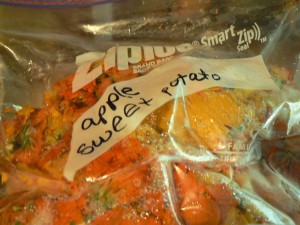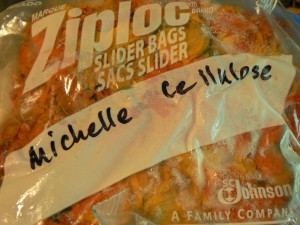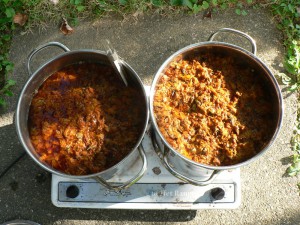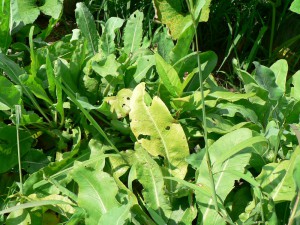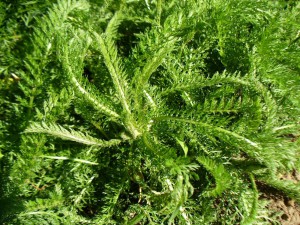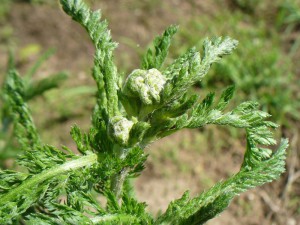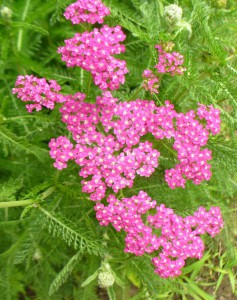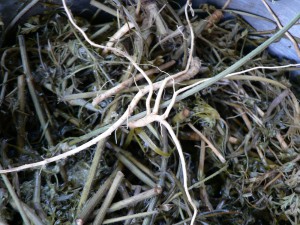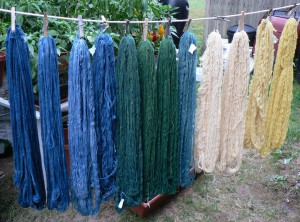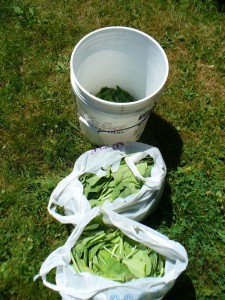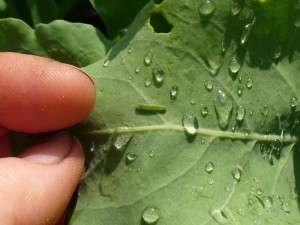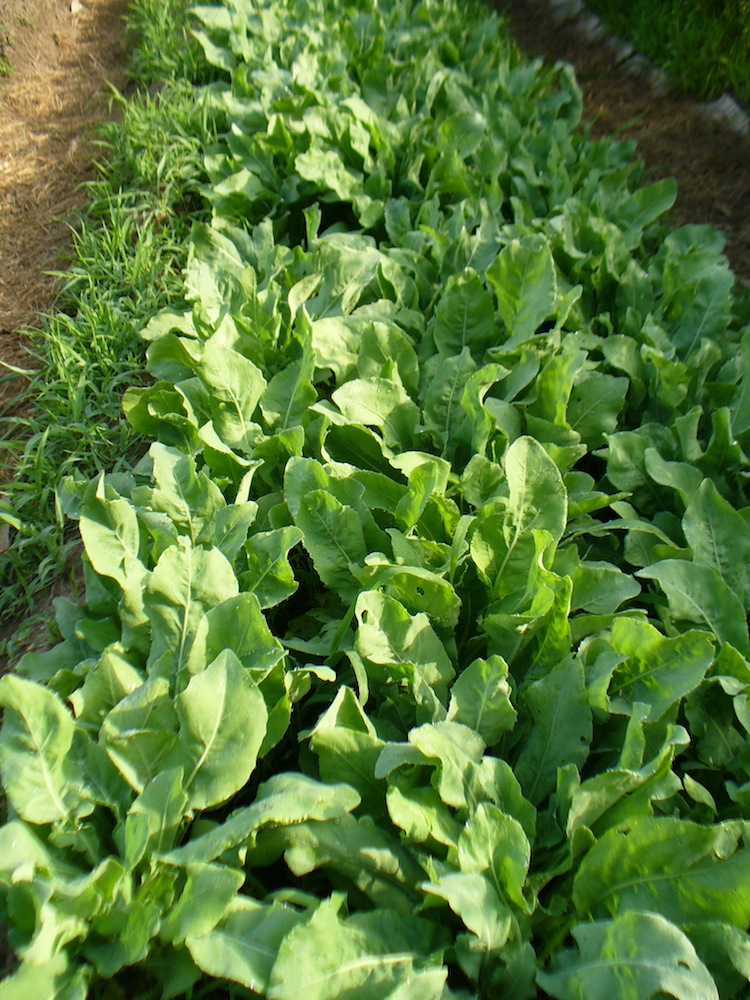Where I live in Massachusetts, our first frost is usually the first or second week of October. I feel like it has been creeping later and later in recent years, but tonight (Friday October 12th) our forecasted low is 25 degrees. I always find the first frost to be a bitter-sweet moment in the gardening year. By the time it comes, Matthew and I are usually up to our eyeballs in chilis and tomatillos, there is no room in the fridge, and we are sick of watering and weeding and squishing bugs and trying to defend beets, corn, pumpkins, or what-have-you from unknown assailants…. Continue reading “First Frost and Woad Thoughts”
Recent Books
Back in September, I finished a custom order of 8 books, which was very satisfying. I used only naturally-dyed pattern weft, in linen, cottolin, and cotton (the warp and tabby wefts were commercial). I had a variety of weld-dyed yellow, madder-dyed pink and terra-cotta, and woad-dyed blue yarns to work with. They were all woven in an overshot pattern called Young Lovers Knot, which I have been using for my book cloth for about a year now.
You may recall my frustration earlier in the spring when I was weaving the cloth, and I was bored of weaving the same pattern over and over again. I complained about it at the time, and then got re-inspired when I bought some new tabby weft colors. I also switched from weaving the design star fashion, which creates boxes and distinct diagonal lines as you weave, to weaving rose fashion, which makes the motifs rounded and gives a sense of concentric circles rippling outward. Continue reading “Recent Books”
Orange Cosmos (Cosmos sulphureus)
At this time of year there are a lot of things to harvest, including dye plants. Some things can be strung up to dry, such as marigold blossoms. Other things, such as orange cosmos flowers, I store in the freezer. When the first cosmos were ready to pick a few weeks ago, I realized that our freezer was still full of bags of cosmos I froze last summer! So on September 1st I decided I’d better make some room. Cosmos are easy to distinguish from pesto, ginger, and the other non-commercial items in our freezer, which is lucky because I had re-used zip-lock bags last summer and you can see that the labels weren’t helpful.
This is not good practice. Label your bags accurately! It is probably also not good practice to store food and non-food things in the same freezer, but we only have one freezer so that’s how it is.
I made a very strong dyebath using 5 lb. of frozen orange cosmos flowers. Since my pots are pretty small, I divided the quantity between two 2-gallon pots, and ran two baths simultaneously.
Orange cosmos are pH sensitive, and you get much redder colors if the pH is high. After straining out the flowers, I used ammonia to increase the pH. I have run out of pH test strips at the moment so I can’t tell you exactly what it was. In the initial dyebaths I added 4 Tbs. ammonia per pot (about one and a half gallons of liquid) before adding the yarn. For each subsequent exhaust bath I added 2 Tbs. ammonia. The yarn is 4 ply rug wool (Helsingin Villakehraamo from Finland, bought at the Hill Institute a few years ago), premordanted with aluminum sulfate.
Another Woad Vat
Yesterday I picked 8 and a half pounds of woad leaves. This is a lot, probably the largest quantity I’ve harvested at one time. Many of the leaves are droopy and yellow at this point in the summer. It has been hot and dry, but there is a lot of color in them, so no worries.
I had written earlier in the summer about woad’s enemies. To fend off the cabbage whites, I planted two hyssop plants, which are supposed to help. I could only find anise hyssop, which may or may not be the right type. It definitely attracts the adult butterflies, as a food source I suspect. But I’m not sure it keeps them from laying eggs on the woad, and it’s the caterpillars that eat the woad leaves, not the butterflies.
I think at this point in the summer that slugs are the main predator on the woad, but I did find quite a few cabbage white eggs. The hyssop is very pretty, though, and it smells great, and the woad is doing OK, so even if the cabbage whites are still laying eggs on it, I guess it’s all fine. Continue reading “Another Woad Vat”
Yarrow (Achillea)
I recently heard a little rhyme about the growth habits of perennials that I couldn’t believe I had never heard before: Sleep, creep, leap. This year my yarrow finally got to the “leap” stage. Yarrow, of course, grows wild all over the place and there isn’t necessarily any need to cultivate it. I have only seen it as a white-blooming wildflower (Achillea millefolium, I believe) which sometimes has a purplish or pinkish tinge. It is beautifully frothy and creamy looking. But I do cultivate it because it comes in such beautiful colors, and I have tried several varieties in the garden over the years. For some reason, the red, yellow, and orange ones have not survived, but this year my pink-flowering ones were lush and tall and bloomed in abundance.
Here is a young little yarrow plant early in the spring. It is feathery and burly at the same time. It looks a little bit like Queen Anne’s Lace when it’s young, and they often grow in similar places. But yarrow is fuzzier, almost furry, and more dense.
Here are some buds. At this stage it can look velvety and fuzzy and silvery grey.
This is what my pink-flowering type looks like in full bloom. It’s cheery, and I find it kind of humorous. The shade of pink is so bright that it entirely over-rides the feathery, lacy quality of the foliage. Continue reading “Yarrow (Achillea)”
More Queen Anne’s Lace
Since Queen Anne’s Lace has been so abundant this year, I wanted to experiment with using the entire plant, roots and all, for dyeing. Quite a lot of plants needed to be weeded out of our garden plot, so on August 2nd I decided to try it. I was pretty certain it would make yellow, which is the most common color from wildflowers, but you never know until you try.
When I am dyeing, I often think of Jill Goodwin’s summary of her dyeing philosophy in her introduction to A Dyer’s Manual (12/24/2023 Edited to add that this link no longer works so I deleted it). I find two of her points especially comforting and motivational:
- “Only use the results of other people as a rough guide, for their conditions will not be the same as your own. Prove everything by your own efforts.”
- “Persevere with each problem, for sometimes after years of thought the solution will become clear.”
So, I do try to prove everything with my own efforts. And I try to persevere with each problem. Hopefully over the years I solve some of them.
I pulled up many plants and chopped them up with pruning shears. I got 4 lbs. 8 oz. of plant material. I liked the cauldron-esque look of the dye pots with stems, leaves, flowers, and especially the roots. Whereas the flowers alone smell lemony and sweet while they are simmering, the whole plant smells a bit more like carrots, as you might imagine. Lemony carrots. Continue reading “More Queen Anne’s Lace”
Queen Anne’s Lace and Woad
Supposedly this blog is about dyeing. Even though I don’t seem to write about it very often, I do sometimes actually dye things. This week I had great success with woolen yarns using Queen Anne’s Lace flowers. Plus I managed a successful woad vat, aerated and everything. Here are the lovely yellows, greens, and blues hanging on the line to dry in the back yard (each skein is about 4 ounces).
Woad Vat Mishap
The other day I very excitedly set about my first woad vat of the summer. There were lots of supplies and equipment to assemble, dirty 5 gallon buckets to wash, yarns to soak. I got everything ready, and harvested seven and a half pounds of leaves from my glorious woad beds. You can tell from the title of my post that I made a big mistake along the way, but I hope to turn it into a learning opportunity for others, so I relate the tale….
Here are the bags of leaves. They were very clean because we have had practically no rain. Sometimes the leaves are muddy so I rinse them off, but not this time.
Woad Has Enemies
Every year I have problems with cabbage white caterpillars eating holes in my woad. Some years are worse than others. The caterpillars are hard to spot and pick off because they are the exact same color as the leaves, or more precisely, the veins. The butterflies are very pretty, of course, because they are butterflies. I have not been able to get a good photo of a cabbage white butterfly (same problem as my earlier bee post), but click on the link above to see some great ones (12/22/2023 Edited to add, the original link stopped working. The new link to UMass Extension is informative but doesn’t have a lot of images.). And the butterflies don’t do any harm, per se. It’s the caterpillars, or cabbage worms, that are the problem.
Here’s a photo of a particularly small and innocuous-looking one sitting on my woad:
Woad is Glorious
My woad beds are looking fantastic! I am very pleased about this. For the past couple summers, the woad plants at Amethyst Brook have been small and feeble compared to the woad I grew up at the dye- and fiber-plant garden at Bramble Hill Farm. This year the garden at Bramble Hill has been sadly neglected (well, I’ve been distracted by multiple flax plots), so the community garden is my sole source of woad. Consequently, I made an extra effort to add plenty of composted manure before planting this year. And ta-da, success. Here is one bed before I weeded it the other day:

